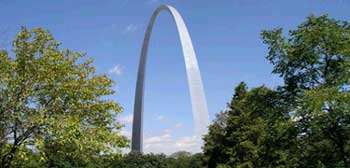






Survey of Historic Sites and Buildings
 |
JEFFERSON NATIONAL EXPANSION MEMORIAL Missouri |
 |
| ||
This memorial celebrates the vision of President Jefferson, the great architect of westward expansion, and all aspects of that vital national movement.
St. Louis, "gateway to the West," was founded in 1764 by Frenchmen from New Orleans and became a center of French-Canadian culture and Spanish governmental control. Conveniently located in relation to the mouths of the Ohio, Missouri, and other Mississippi tributaries, it became the hub of midcontinental commerce, transportation, and culture—the place where East met West and jumping-off point to the wilderness beyond. A base of operations for traders, travelers, scientists, explorers, military leaders, Indian agents, and missionaries, it was also headquarters of the Western fur trade and focus of advanced scientific and political thought in the West.
Along the St. Louis waterfront, hulking steamboats from the East and South met the smaller river boats that served the frontier communities and outposts on the upper Mississippi and Missouri Rivers. At this major transfer point, a small but teeming city, mercantile establishments, boatyards, saloons, and lodginghouses served and supplied the westbound settlers and other frontiersmen who congregated there before setting out across the Plains. Oregon and California pioneers and gold seekers bought tools, wagons, guns, and supplies; lumbermen, planters, farmers, and fur dealers sold their products; and artisans fashioned Newell & Sutton plows, Murphy wagons for the Santa Fe trade, Grimsley dragoon saddles, Hawken "plains" rifles, and the cast-iron stoves of Filley, and Bridge & Beach.
To dramatize westward expansion and the great cultural, political, economic, and other benefits that followed in the wake of the Louisiana Purchase of 1803, an extensive development program for the memorial has been undertaken by the National Park Service and the Jefferson National Expansion Memorial Association, a nonprofit organization of public-spirited citizens. Crowded, obsolescent industrial buildings have been cleared away as part of a broad urban renewal program.
 |
The dominant feature of the memorial—on the site of the original village of St. Louis—is a 630-foot-high stainless steel arch, designed by the noted architect Eero Saarinen, and completed in 1965. Rising from the west bank of the Mississippi River, it symbolizes the historic position of St. Louis as gateway to the West. It contains an elevator system enabling the visitor to reach an observatory at the top. Scaled to the heroic dimensions of such structures as the Washington Monument, the Eiffel Tower, and the Statue of Liberty, it ranks with them in size and grandeur.
An underground visitor center, featuring a Museum of Westward Expansion—under construction at the time this document was written and was temporarily located in the Old Courthouse—is located at the base of the arch. Museum exhibits portraying the experiences and contributions of Western explorers, fur traders, statesmen, overland emigrants, soldiers, miners, Indians, cattlemen, and farmers present our Western heritage in new dimensions. Guided, as well as self-guided, tours for visiting groups are provided. The devices and services used in telling the story of westward expansion will be enriched through the years by continuing historical research.
Two historic buildings are preserved at the memorial. One is the Old Courthouse, constructed during the period 1839-64. It was the scene of the first trial in the famous Dred Scott case and the dominant architectural feature of the town during the years that St. Louis was "emporium of the West." Its rotunda resounded with the oratory of Thomas Hart Benton and other famed speakers of the 19th century. At the courthouse Senator Benton delivered his famous oration, using as his theme Bishop Berkeley's poetic phrase "Westward the course of empire." The second historic structure is the Old Cathedral, built during the years 1831-34 on church property set aside at the time of the founding of St. Louis. It was at one time the seat of the archdiocese, but is now a shrine and place of worship.
The Jefferson National Expansion Memorial was designated as a National Historic Site by Executive order in 1935. It occupies an area of more than 80 acres.
 |
 |
http://www.cr.nps.gov/history/online_books/prospector-cowhand-sodbuster/sitea2.htm
Last Updated: 22-May-2005